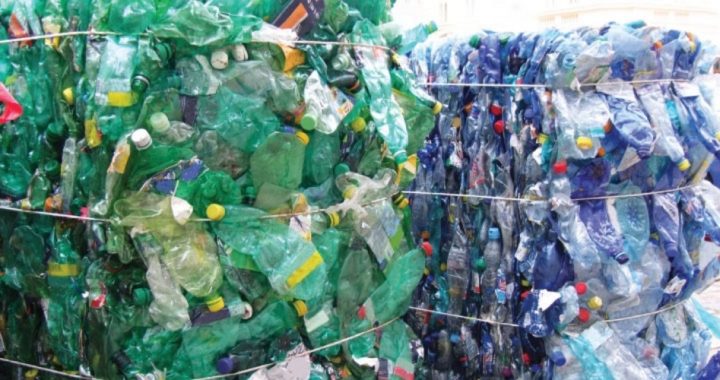
When the first Earth Day observance was staged on April 22, 1970, 20 million Americans gathered at various venues across the country, in order to demonstrate for a healthy, sustainable environment. One of the ideas promoted as an agenda action item was that of recycling, particularly as it related to things made from metal, glass, paper, and plastic. This idea was considered to be a no-brainer, to be accepted virtually without question. After all, had not generations of Americans been raised on the admonition, “Waste not, want not!”?
And so municipalities from coast to coast started setting up recycling programs in order to encourage people to become responsible stewards of the environment. With the passage of time, as often happens when the heavy hand of government gets involved, what started out as voluntary eventually became compulsory, to the point where curbside recycling is now almost as prevalent as curbside garbage collection.
Disposing of Junkie Ideas
After more than four decades, we have now had enough experience with recycling to see that it is not the panacea that it was cracked up to be. In some cases, the downside is so obvious that even an elementary-school student can grasp it. Brooke Williamsen, a sixth grader in Appleton, Wisconsin, made the following observation in a report that she wrote as a class project:
Recycling doesn’t save energy as compared to using virgin raw materials either. Most recycling websites talk about the benefits of recycling and claim that recycling saves lots of energy. The websites claim recycling aluminum requires 95% less energy than making brand new aluminum. Or that recycling paper saves 64% more energy than brand new paper. Or that recycling plastic saves up to 60% more energy than making brand new plastic. However, an Ohio State University fact sheet said, “The average saving … does not include added energy costs of collection and transportation.” When the energy of recycling collection is figured out, recycling actually uses more energy. Curbside collection of recycling materials uses lots of energy. One way that it uses lots of energy is in the making of recycling trucks, which are made out of steel, which consumes lots of energy to make. And these trucks have limited life spans. After awhile the trucks are going to break and need to be replaced. Another way recycling uses lots more energy than disposal is the fuel used to run the trucks. For every trip to the landfill to haul plastic, paper, and aluminum as trash, it would take 5-10 trips to the recycling center. This is because when plastic, paper, and aluminum are put in a garbage truck, they are compacted together so that much garbage can be hauled in one load. But when recyclables are hauled in a recycling truck, they are not compacted together because when the recyclables get to a recycling center, material that is not recyclable has to be sorted and removed. Experts who study this matter know that it costs a lot more to recycle. One of these experts is Leland E. Teschler, the editor of an engineering website, who said in his paper Don’t Recycle: Save Energy, “The issue has been closely examined by the Franklin Associates Div. of the Eastern Research Group. Franklin has for years prepared the national characterization of municipal solid waste published by U.S. EPA [Environmental Protection Agency]. It also has looked at the cost per ton of handling recyclables through curbside pickup. One of Franklin’s conclusions is that curbside recycling typically costs 55% more than simple disposal because it consumes huge amounts of capital and labor per pound of recycled material.” It is obvious that recycling costs more than disposing because if recycling were beneficial, citizens wouldn’t be charged for pick-up. (Most people are charged on their tax bills.) Plastic, paper, and aluminum companies buy raw materials, and if recyclables saved energy, then these companies could buy the recyclables cheaper than the raw materials, and cities or businesses could collect the recyclables and sell them to plastic, paper, and aluminum makers for less than the cost of typical raw materials.
That excerpt from Brooke’s report blows out of the water the argument that curbside recycling saves resources. In fact, instituting a curbside recycling program is essentially moving from once-a-week trash collection to twice-a-week trash collection. Or, if curbside recycling pickups are carried out every other week, it is basically a case of moving from four rubbish pickups per month to six rubbish pickups per month. To make the argument that increasing the number of curbside pickups saves resources would strain the credulity of any rational person. Only hidden government subsidies and creative accounting make it superficially appear that curbside recycling saves resources.
As also pointed out in Brooke’s commentary, if it truly made economic sense to institute a curbside recycling program, then it should not cost the consumer anything. Furthermore, if the payback outweighed the costs involved, then the local government should not have to mandate any kind of recycling program at all because the private sector would rush in to take advantage of a profitable opportunity. In fact, recycling is economically feasible in many situations, such as recycling various metals. That is why one can observe the classic scene of a homeless person pushing around a shopping cart while scavenging for aluminum cans to toss into it. Due to its somewhat unique chemistry, it takes enormous amounts of electricity to separate the aluminum metal from the ore, even though aluminum is the most abundant metal in the Earth’s crust. Recycling aluminum requires only five percent as much energy as obtaining the metal from the ore. Indeed, slightly more than half of the aluminum used in the United States is the product of recycling. And in countries such as Brazil and Japan, the recycling rate is more than 80 percent. But while privately owned scrap yards can exist as a viable business by purchasing scrap metal and then selling it to smelters, scrap yards generally do not engage in curbside pickup, for the very reasons cited in the excerpt above from Brooke’s article. Despite that lack of curbside collection activity, the Institute of Scrap Recycling Industries reports that its members recycle a greater amount of metal, glass, paper, and plastic than the recycling programs of all levels of government (local, county, and state) combined.
Finding Room for Trash
Although the environmentalists lose the argument on the economics of curbside recycling, their support for such recycling programs relies on a host of other arguments that initially appear to be at least somewhat convincing. However, on closer inspection, they turn out to be little more than fallacies. One of those arguments is that, without mandated curbside recycling programs, we would not be able to handle all of the trash that we produce. Up until World War II, there were hundreds of giant incinerators around the United States that simply burned the bulk of rubbish produced by consumers. The advantage derived from burning trash was the reduction in disposal volume by anywhere from 85 to 95 percent. The disadvantage was that it produced offensive odors, noxious gases, and irritating particulate matter in the smoke. After World War II, concerns about air pollution led to a gradual replacement of incinerators by so-called “sanitary landfills,” in which all forms of trash were dumped in a suitable place and then buried.
During the 1980s, reports started surfacing that the country might be running out of places to dump its garbage, as the number of operating landfills began to fall significantly. Sloppy analysis by the Environmental Protection Agency (EPA), the media, and commentators, such as then-Senator Al Gore and science fiction writer Isaac Asimov, focused on the number of landfills, rather than the capacity of the landfills that were in operation. Due to new EPA regulations, as well as mergers and consolidations within the waste disposal industry, there had been a move to use new, much larger landfills, while smaller and less economical landfills were being shut down. So, while the clueless Chicken Littles were running around in a panic trying to warn us of an impending crisis, overall landfill capacity was actually increasing. Various studies have attempted to estimate how much space will be needed to handle America’s trash in the foreseeable future. According to Bjorn Lomborg, author of The Skeptical Environmentalist, if New York City’s Fresh Kills landfill operation on Staten Island were used as a yardstick, where trash was piled up to a height of 255 feet, all of the trash produced in the United States over the next 100 years could fit on a square patch of land measuring approximately 10 miles on each side. Hence, the contention that we need curbside recycling in order to prevent future generations from being buried under a mountain of garbage is clearly absurd.
Burying a Poison Pill
A corollary to the notion that we will be buried by our own rubbish if we do not recycle our reusable trash is the argument that vast amounts of accumulated waste will eventually poison us. While this argument is a little bit harder to refute, it still amounts to making a mountain out of a molehill. Even the EPA admits that the threat to humans from modern-day landfills is virtually nonexistent. Three studies conducted during the 1990s concluded that today’s landfills could be expected to cause one cancer death every 50 years. Keep in mind that cancer kills more than half a million people in the United States every year. In other words, a person is far more likely to be killed by lightning, or choke to death on a piece of steak than be killed by cancer caused by a landfill. While it is true that older landfills are not as well designed as modern landfills and, therefore, carry a higher risk of causing a public health problem, curbside recycling will do nothing to address that issue. The potential hazards from landfills occur when toxic industrial wastes are illegally dumped into municipal landfills, instead of being processed and disposed of properly. Again, a curbside recycling program does nothing to resolve that problem. As with the argument above, the idea that future generations will be poisoned by our waste unless we carry out curbside recycling programs is ridiculous.
Space Ship Earth
Another classic argument in support of recycling is that we live on a kind of “Space Ship Earth,” with finite resources and an expanding population. The implication is that, if we do not recycle, then we run the risk of depleting essential resources. That is the argument behind the Malthusian theory that the human population tends to increase faster than its means of subsistence, which will ultimately lead to some kind of global calamity. We have been waiting 200 years for the arrival of the widespread poverty and degradation that Thomas Malthus predicted back in 1812. If anything, we seem to be moving further and further away from the disaster that he predicted. There are at least a couple of reasons for that.
As the old saying goes, “Necessity is the mother of invention.” When one observes human history, one sees that problems are continually being resolved. Human progress means that technological advances are continually coming to the fore, increasing productivity, and proving the pessimists wrong. Not only is production trending upward, but prices (adjusted for inflation) are trending downward. In fact, this phenomenon was the subject of a famous wager between business professor Julian Simon and biologist Paul Ehrlich that Wikipedia describes as follows:
In 1968, Ehrlich published The Population Bomb, which argued that mankind was facing a demographic catastrophe with the rate of population growth quickly outstripping growth in the supply of food and resources. Simon was highly skeptical of such claims, so proposed a wager, telling Ehrlich to select any raw material he wanted and select “any date more than a year away,” and Simon would bet that the commodity’s price on that date would be lower than what it was at the time of the wager.
Ehrlich and his colleagues (including John Holdren, later an advisor to President Barack Obama for science and technology) picked five metals that they thought would undergo big price increases: chromium, copper, nickel, tin, and tungsten. Then, on paper, they bought $200 worth of each, for a total bet of $1,000, using the prices on September 29, 1980, as an index. They designated September 29, 1990, 10 years hence, as the payoff date. If the inflation-adjusted prices of the various metals rose in the interim, Simon would pay Ehrlich the combined difference. If the prices fell, Ehrlich et al. would pay Simon.
Between 1980 and 1990, the world’s population grew by more than 800 million, the largest increase in one decade in all of history. But by September 1990, the price of each of Ehrlich’s selected metals had fallen. Chromium, which had sold for $3.90 a pound in 1980, was down to $3.70 in 1990. Tin, which was $8.72 a pound in 1980, was down to $3.88 a decade later.
As a result, in October 1990, Paul Ehrlich mailed Julian Simon a check for $576.07 to settle the wager in Simon’s favor.
That’s right; in some cases, the price of the commodity was lower even in absolute terms, without adjusting for inflation! That is because another factor is at play: substitution. When something becomes relatively more expensive with the passage of time, people have a way of finding less expensive substitutes. For example, while silver is the best conductor of electricity, it is prohibitively expensive to use in large quantities. So, copper wire is used in place of silver wire, and now even copper wire is being replaced by fiber optic cables. Once again, it is virtually impossible to see where curbside recycling would have any decisive role to play in preventing a Malthusian-style catastrophe.
In the final analysis, the environmental movement in general, and curbside recycling in particular, is not driven by science, economics, or even common sense but, rather, it is driven by politics and the pursuit of raw power. The federal politicians and bureaucrats want to worm their way into every nook and cranny of our lives.



